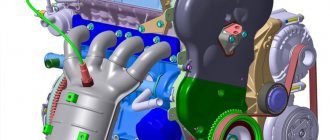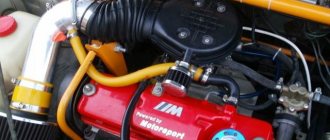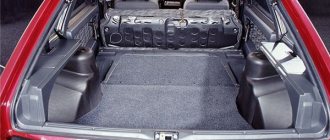VAZ-2109 is a domestic Samara-Sputnik, one of the cars of the former Soviet Union, whose production began back in 1987. Then, 4 years later, in 1991, it was replaced by the VAZ-21093, the technical characteristics of which already included a more powerful 1.5 liter engine. In those years, buying a “nine” (as it was popularly called) or a 93 model was considered great luxury. And although the Union has been gone for a long time, 2109 is still in demand, despite the newfangled features of the Priora and Kalina. What caused this popularity?
In order to answer this question, let’s remember what made Samara stand out. After all, at that moment it was impossible to surprise anyone with a 1.5 liter engine. Earlier models also had such capabilities. As they write, the VAZ-21093 car had front-wheel drive, inherited from its mother - a “nine”, a 5-speed manual and only 6 liters on the highway. It seems like nothing special, but if you sit in the cabin: front windows, headlight adjustment, subsequently the appearance of a tachometer, and some happy car owners could boast of central locking.
Please note that panel 2109 does not have a tachometer. Even when it became a foreign car (we are talking about the 2109 Baltic), it did not acquire a tachometer. Photos of the panel for Baltic can be seen in this article.
"Satellite"
Those who remember Soviet prices, especially those who owned such a car, will agree that 6 liters per 100 km for a family of 3-4 people was a completely acceptable financial burden. But this “Sputnik” made it possible to organize tourist excursions over long distances.
Rear seats for two children in a family, a spacious trunk, low fuel consumption, plus some bells and whistles that the owners of earlier Zhiguli cars could not boast of - you get the VAZ-21093. We will look at the technical characteristics of the car below, but the entire automobile industry of those times did not have a more comfortable car, suitable for both city and country roads. “Nivas,” “fours,” and “twos” don’t count, because when we folded the rear seats, we got a semi-truck version that was larger in volume than the named models. You can mention model 8, the same Sputnik, but do not forget that the “nine” has five doors versus three for the 2108.
VAZ 2109 injector controller
The controller receives the necessary information from the sensors, then makes calculations: based on them, it independently issues commands to the actuators. This device is quite reliable. One problem: it is afraid of large surges in on-board voltage. This can happen when the generator malfunctions or the starter sticks while the engine is running; sometimes the process of “lighting” another car or the use of a low-quality starting charger is to blame.
As soon as malfunctions occur, the controller immediately detects them, notifies the driver with the above-mentioned lamp, and stores the codes. Under his control, the injectors try to work smoothly, as does the ignition system.
The injectors turn on in pairs, but this depends on the type of controller itself. An interesting fact is that pairs of injectors tend to turn on alternately, approximately 180° from the crankshaft rotation. This is called double synchronous injection, but sequential operation is possible. An idle spark is provided for the system: 16-valve engines are an exception. They are already equipped with personal ignition coils for each spark plug.
This process occurs as follows: high-voltage pulses are applied to a specific pair, and the formation of a working spark occurs in the cylinder on the compression stroke and on the exhaust stroke. Otherwise, an idle spark will form. In this case, a small amount of energy is required for the cylinder during the exhaust stroke, and the rest of it is used during the compression stroke. This is how the process of ensuring normal sparking and unhindered ignition of the fuel mixture occurs. The whole process can be repeated if the cylinders decide to switch roles unexpectedly.
The controller controls not only the fuel supply, but also the energy accumulation time and ignition timing. This concerns the crankshaft rotation speed in idle mode, the uninterrupted operation of the electric fuel pump, the tachometer and the warning lamp, which is located on the VAZ instrument panel, the cooling system, and the cabin air conditioning compressor clutch. The device generates certain speed signals to the trip computer, regulates fuel consumption, and maintains the required stereochemical ratio (gasoline-air as 1:14.7).
Appearance of the injector
With the development of production, very soon after the launch of the 2109 model, the VAZ-21099 sedan appeared at AvtoVAZ, which already came with an injection engine. However, the great popularity of the hatchback forced the VAZ team to reconsider plans for the 2109. In 1991, a year after the launch of the 99th model, the VAZ-21093 injector appeared, the technical characteristics of which became the norm for all future nines. As they wrote in press releases of those times, this model is more suitable for a family man and has a less expressive appearance than the 2108. However, with the advent of the 99 model, which received an injector before the 93, the star of Sputnik at AvtoVAZ very soon waned. The model was supported by Ukraine, but production has been discontinued since 2011. It is interesting to note that in Ukraine the car retained its original name, despite the fact that it was assembled at the same plant where Zaporozhets, Tavria and subsequent brands were.
VAZ 2109 injector does not start
Problem: the car worked fine all day and drove dozens of kilometers around the city. I stood in the garage resting for several hours. The owner decided to go out again on business, but could not start it. It seemed like something was catching, but then it died out. I had to unscrew the candles, which were thoroughly wet, and put the ones I had just bought in their place. And again a bummer! I had to check the timing belt: it turned out to be normal, I removed the battery and examined it for a failure. I checked the fuel pump: it is also ok. There is a return line, there is fuel too, but the car just doesn’t want to start.
Tips: heat the spark plugs, screw them in hot, try to start them. If the result is negative, then we can assume that the fuel was filled with low-quality gasoline; blow out the engine with the module turned off, and add a little oil to the cylinders; carefully inspect the wire near the sensor: it often breaks in this place. The terminal area is a vulnerable spot. Try to touch it, a spark should jump out.
Misconceptions
There are several opinions regarding the specification of the VAZ-21093 model. Technical characteristics: injector, 1.5 liter engine, front-wheel drive, 5 doors, etc. At the same time, other reference literature may indicate other data that includes the same characteristics, with the exception of 1.6 liter engine capacity. But according to the factory specification, all 99, and then 93 models had only a 1.5-liter engine. Yes, there were almost 1600 without a few units, but the specification still classifies them as class 1.5. The batch with a liter engine, which was produced on the basis of the same “mother”, has nothing to do with 93, because it was called 21091.
Carburetor. Advantages and disadvantages
Let's start with the negative points. These include:
- Such engines have not been installed on production cars for a long time. In Europe, due to environmental requirements, carburetors are blacklisted. That is, they are prohibited because they heavily pollute the atmosphere;
- At high speeds, the engine's capabilities drop significantly. Torque does not reach the desired levels. But at low speeds it is effective and allows you to accelerate well from zero to hundreds;
- When overtaking, the carburetor is a pain. It is problematic to overtake cars normally and confidently. Especially considering the power of the carburetor nines;
- High fuel consumption when compared with injection engines. On average, a nine with a carburetor in normal mode consumes about 8.5-9 liters of fuel per 100 kilometers;
- The air damper is controlled manually. The exception is some versions of the latest samples, where automatic devices have been installed. Some motorists claim that manually controlling the throttle in winter has its advantages, as it allows you to feel the engine. But only experienced drivers can understand this.
But let's not just talk about the bad. The VAZ 2109 with a carburetor also has positive qualities:
- The cost of a carburetor is much cheaper than an injection engine;
- Engine maintenance costs less, and the work itself is easier to perform if you repair it yourself;
- Fans of carburetors claim that the absence of control units and microcontrollers is an undeniable advantage. Although one can argue with him;
- If the engine fails even 100 kilometers from the nearest settlement or service station, it is not a problem for experienced drivers, since repairs can be carried out even in the field. But this will require the availability of appropriate tools and passenger assistance.
Swapping a couple of armored pipes and doing a purge is a simple option for quickly repairing a carburetor yourself. The injection engine does not understand such tricks.
Article on the topic: Features of replacing the rear brake cylinder 2114
Injector. Advantages and disadvantages
In short, all the advantages of the injector are the disadvantages of the carburetor, and all the disadvantages are the advantages of the carburetor.
The key features of injection engines include:
- Injectors are more environmentally friendly and meet the requirements for emissions of harmful substances;
- Although the torque is insufficient at low speeds, it makes overtaking easier at high speeds. The engine seems to get a second wind;
- Injector maintenance costs are higher;
- For normal operation of such an engine, clean fuel is needed. The carburetor “feeds” on everything;
- To check faults, it is necessary to perform diagnostics, which is time-consuming and expensive;
- The injector consumes less fuel. The average is 6-7 liters per 100 kilometers;
- Almost all systems function through computer control, therefore, when working correctly, the engine operates as efficiently and economically as possible;
- It is possible to install HBO on the injector. But with a carburetor, such a step is fraught with a number of difficulties.
Injector or carburetor?
It should be noted that the 93 model was produced in 2 stages. And the main part of the early cars (before 1994) differs from subsequent VAZ-21093 cars. The technical characteristics of carburetor cars are similar to 2109 and 2108. Starting from 1994, and then from 1997, the characteristics of the 93 model began to be exactly the same as the 99 (except for the body): 1.5 liter engine, front-wheel drive, 5-speed manual transmission, system fuel supply from 99, etc. It was because of the appearance of the injector that 93 received new wings, and 99 became longer than the previous ones.
History of VAZ - how did a domestic car with an injector appear?
Serial production of VAZ 21093 cars began in the late 80s. At that time, the VAZ was produced only with a carburetor engine. The main difference between this car model and its predecessor, the VAZ 2108, was the presence of 5 doors, which is why it began to be considered a family car.
The production of the VAZ 21093 with an injector began in 2000, when the so-called electronic brains appeared - primitive on-board computers that control all electronic processes in the operation of the car. The presence of connectors allows a car service center to diagnose the car and determine faults without delving into the insides of the car. The on-board computer can see malfunctions of sensors, turn signals, headlights, ignition systems, and problems with engine operation.
Since 2012, the VAZ 21093 has received another advantage - an electronic gas pedal, which is a pleasure to press! The driver does not need to make almost any effort - just put his foot on the pedal for the car to start.
Joint venture
It is impossible not to mention the term that was often used in those years. These letters (SP) were also used at the plant in Togliatti. This is how Carlotta appeared - a modification of the Belgians, and 9 Baltic - a joint production with Finland. According to official data, the prototype model 93 was modified - 2109, but in the same years one could also find “Carlotta 93” - a modified model assembled on the basis of the VAZ-21093.
This is what Carlotta looked like. A distinctive feature by which it was recognized even in dense traffic is its dual headlights. And not a dummy, as some Russian craftsmen did with the flat headlights of the Sputnik, but precisely 2 pairs of headlights that turn on separately, like on a six.
And this is what the panel of the European Lada looks like (photo above): a different steering wheel, a different backlight, a different appearance, but the main design features of the panel of the ninth Sputnik still remain unchanged.
Rework
To replace a carburetor with an injector yourself, be sure to arm yourself with the following components:
- Cylinder head from VAZ 2112 with receiver and manifolds;
- Knock sensor;
- Throttle pipe with throttle position sensor;
- Mass air flow sensor and a number of other elements.
When everything is ready, you can start working.
- Remove the old cylinder head. Plus, remove all attachments in the fuel assembly, gas tank and ignition system.
- Remove the alternator, thermostat, pulleys and belts.
- Install a new gas tank with a pump, borrowed from a donor - an injection VAZ.
- Remove the carburetor and ignition system components that need to be replaced.
- Disconnect the cooling system pipes and hoses. Here, install a completely new kit from the injector.
- Remove the pan.
- Install new pistons from an injection donor and connecting rods at 10. Standard carburetor components are not designed for an injection compression ratio. Plus there are special recesses for other valves.
- Install a new unit with an underflow on the cover for the DPKV, replacing the standard oil pump. If you can remove the cover, then only that will be replaced.
- After removing the old cooling system pipes, install new ones. The best solution is to replace the entire set. Buying it won't really impact your overall budget.
- Prepare everything necessary to mount the 16 valve head. The fasteners match, only the bolts from the old head are long and need to be shortened. Plus, don’t forget to make a size 12 hole in the new head.
- Install new fuel lines from the donor.
- Connect your new gas tank to the lines.
- Route the wiring from the control unit to the fuel pump. You can use old fuel level regulators from a carburetor car.
- Cut a hole in the wall of the engine compartment through which the wiring will be routed. This way you won't have to make the standard wires longer.
- Install the knock sensor by drilling a hole in the block and tapping a size 8 thread.
- Be sure to replace the water pump using a unit from donor 2112.
- Get a new crankcase breather and oil dipstick. Install them instead of the previous ones.
- Install a new cylinder head. Just don't forget to change the gasket, which corresponds to a different head.
- Install a thermostat borrowed from a VAZ 2112.
- Connect the coolant pipes.
- Remove the rear timing cover and rollers. The pulleys from 2112 are dismantled. The belt must be installed in accordance with the marks.
- Install the new generator along with the drive. For the new generator, the upper fasteners will remain intact, since they are not provided for by the design of the carburetor VAZ 2109. Therefore, fasten the pair of lower mounting bolts as securely as possible.
- Place all the sensors in their new places.
- Seal the valve covers with a good quality sealant.
- Assemble the ignition module, wires, spark plugs and other components.
- Install the air filter.
- Get your exhaust system back to normal. The muffler is often left stock, but the resonator and other components are taken from the donor.
- The wiring is connected to the dashboard and the lock.
- Fill in new oil, refuel the car with high-quality fuel.
- Start the engine and take it for a test drive.
Article on the topic: Installing Euro handles on a VAZ 2114 with your own hands
Specifications
It's time to look at the characteristics of our VAZ-21093. Technical specifications, body type, overall dimensions and other information are presented below.
Apart from the details that are indicated a few paragraphs above, the design of the VAZ-21093 (principal, electrical and other circuits) replicated the VAZ-21099 with a high degree of accuracy, except that it was one of the first hatchbacks in the Soviet Union.
Price and options
The “nine” did not have a special level of comfort, so there is simply nothing to describe to a greater extent. Even then, it was in many ways superior to foreign cars. But the domestic hatchback was distinguished by its maintainability and the presence of the necessary parts.
The steering wheel did not have a hydraulic booster, so you had to physically work hard. There was a standard heater, a simple steering wheel and standard seats with seat belts installed.
It was possible to adjust the external mirrors from the interior using a mechanical lever. Today, the VAZ 2109 can only be purchased on the secondary market. Usually the price tag for this car is low, so you can buy a car on the go from 60,000 rubles.
And a little more separately about Baltic
Strictly speaking, this car is not a joint production. “Lada-Baltic” is a completely separate line, which was assembled in Finland, a European country, for the European consumer. VAZ had to reach an agreement after sales of export cars began to decline. The quality of our transport has not always been stable, and the Baltic project was born just at the time of one of these cases.
The only thing that remained old about the car was its appearance. At the same time, a foreigner can also be distinguished by its design. Firstly, completely different colors, and secondly, the bumpers, sills and window trims were painted in the general tone of the car (this is how luxury cars looked). Thirdly, it was from these models that the Union came up with the idea of using metallic colors. All color schemes of this Lada came from the metallic line. It can be said, fourthly, that pure black color was not presented in Europe. These colors were produced only for domestic consumers. It is also interesting to note that the Finns have gone further than Russia. On the Internet there are photographs of cars produced in Finland with other bodies.
About the preferences of motorists
Owner reviews of these cars differ little from each other. The models are structurally similar and have the same disadvantages. The main ones are severe corrosion of the body, as well as an interior that rattles on uneven surfaces.
Many people do the tuning themselves. The improvements, for the most part, concern minor changes in the appearance and interior. An example of tuning can be easily found on the Internet - read the relevant articles or watch a video.
Electrical diagram of VAZ-21093 and VAZ 21099
The turn signals on the VAZ 2108, 2109, 21099 do not work
1 — headlight block; 2 — electric motors for headlight cleaners; 3 — fog lights; 4 — engine compartment lamp switch; 5 — sound signal; 6 — electric motor of the engine cooling system fan; 7 — fan motor activation sensor; 8 — front brake pad wear sensor; 9 — generator VAZ 21099; 10 — solenoid valve for turning on the headlight washers; 11 — solenoid valve for turning on the rear window washer; 12 - solenoid valve for turning on the windshield washer; 13 — electric motor for windshield washer; 14 — oil pressure warning lamp sensor; 15 — oil level sensor; 16 — washer fluid level sensor; 17 — fuel consumption sensor; 18 — carburetor solenoid valve; 19 — carburetor limit switch; 20 — starter activation relay; 21 — spark plugs; 22 — ignition distributor sensor; 23 — vehicle speed sensor; 24 — carburetor solenoid valve control unit; 25 — diagnostic block; 26 — ignition coil; 27 — reverse light switch; 28 — coolant temperature indicator sensor; 29 — starter; 30 — sensor of the 1st cylinder; 31 - switch; 32 - battery; 33 — coolant level sensor; 34 — relay for turning on fog lights; 35 — brake fluid level sensor; 36 — mounting block; 37 — plug socket for a portable lamp; 38 — door lock control unit; 39 — engine compartment lamp; 40 — electric motor for windshield wiper; 41 — glove box lighting lamp; 42 - electric motor of the heater fan; 43 — additional resistor of the heater electric motor; 44 — heater fan switch; 45 — lamp for illuminating the heater levers; 46 — gear motors for electric windows of the front doors; 47 — gearmotors for locking front door locks; 48 — gearmotors for locking rear doors; 49 — ignition switch; 50 — right door power window switch; 51 — left door power window switch; 52 - ignition relay; 53 — steering column switch; 54 — trip computer; 55 — cigarette lighter; 56 — lighting regulator for VAZ 21099 devices; 57 — parking brake warning lamp switch; 58 — brake light switch; 59 — control lamp for turning on the heated rear window; 60 — rear window heating switch; 61 — fog lamp switch; 62 — control lamp for turning on fog lights; 63 — indicator lamp for turning on the rear fog light; 64 — rear fog light switch; 65 - side direction indicators; 66 — lamp switches on the door pillars; 67 — fog light circuit fuse; 68 — external lighting switch; 69 — instrument panel VAZ 21099; 70 — switch for the carburetor air damper warning lamp; 71 — alarm switch; 72 — lampshade; 73 — connector for connecting to the individual lighting lamp; 74 — rear lights; 75 — license plate lights; 76 - electric motor for rear window wiper; 77 — rear window heating element; 78 — sensor for level indicator and fuel reserve.
For all questions about repairs, please contact the FORUM
Schemes for cars
| SE TUBE AMPLIFIER |
Advantages and disadvantages
Pros of the car
- Inexpensive Soviet-made car;
- Front-wheel drive can certainly be considered an advantage;
- Acceptable ride height;
- Good dynamics, high speed, pleasant handling and sufficient stability on different surfaces;
- Heating and ventilation cope well with their tasks and supply air to several points at once, which improves the uniform distribution of thermal air throughout the cabin;
- Acceptable fuel consumption;
- Ideal for tuning;
- Availability of spare parts and good maintainability.
Cons of the car
- Corrosion of metal;
- The appearance is clearly not for everyone;
- A small resource of some details;
- Mediocre sound insulation of the cabin;
- Low equipment;
- There is very little free space, especially for rear passengers;
- Small luggage compartment;
- Poor maneuverability;
- Poor quality interior;
- Low level of security;
- The power unit clearly lacks power.











